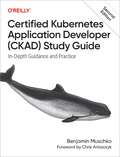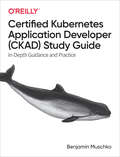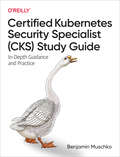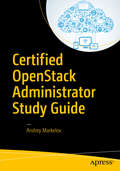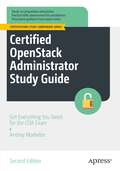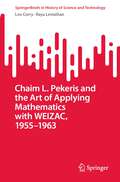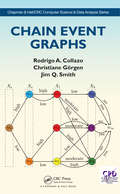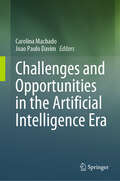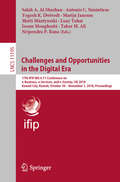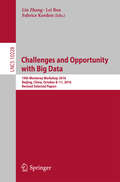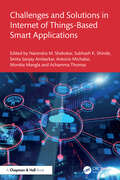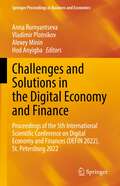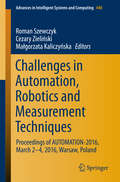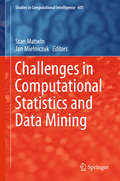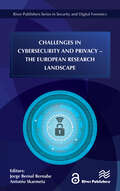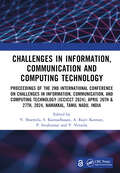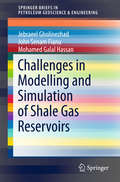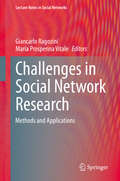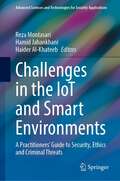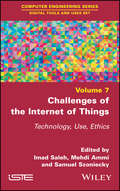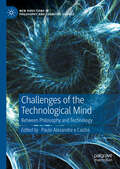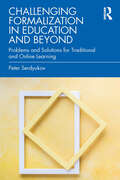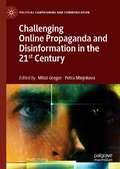- Table View
- List View
Certified Kubernetes Application Developer (CKAD) Study Guide: In-Depth Guidance and Practice
by Benjamin MuschkoDevelopers with the ability to operate, troubleshoot, and monitor applications in Kubernetes are in high demand today. To meet this need, the Cloud Native Computing Foundation created a certification exam to establish a developer's credibility and value in the job market for work in a Kubernetes environment.The Certified Kubernetes Application Developer (CKAD) exam format is different from the typical multiple-choice format of other certifications. Instead, the CKAD is performance-based and requires deep knowledge under immense time pressure.Updated to reflect revisions to the official curriculum made in September 2022, this revised study guide takes you through all the topics you need to fully prepare for the exam. Author Benjamin Muschko also shares his personal experience and tips.Learn when and how to apply Kubernetes's concepts to manage an applicationUnderstand the objectives, abilities, tips, and tricks needed to pass the CKAD examExplore the ins and outs of the kubectl command-line toolSolve real-world Kubernetes problems in a hands-on command-line environmentNavigate and solve questions during the CKAD examNew topics include: Deployment strategies, the Helm package manager, resources that extend Kubernetes (CRD), building container images, and more
Certified Kubernetes Application Developer (CKAD) Study Guide: In-depth Guidance And Practice
by Benjamin MuschkoDevelopers with the ability to operate, troubleshoot, and monitor applications in Kubernetes are in high demand today. To meet this need, the Cloud Native Computing Foundation created a certification exam to establish a developer's credibility and value in the job market to work in a Kubernetes environment.The Certified Kubernetes Application Developer (CKAD) exam is different from the typical multiple-choice format of other certifications. Instead, the CKAD is a performance-based exam that requires deep knowledge of the tasks under immense time pressure.This study guide walks you through all the topics you need to fully prepare for the exam. Author Benjamin Muschko also shares his personal experience with preparing for all aspects of the exam.Learn when and how to apply Kubernetes concepts to manage an applicationUnderstand the objectives, abilities, tips, and tricks needed to pass the CKAD examExplore the ins and outs of the kubectl command-line toolDemonstrate competency for performing the responsibilities of a Kubernetes application developerSolve real-world Kubernetes problems in a hands-on command-line environmentNavigate and solve questions during the CKAD exam
Certified Kubernetes Security Specialist (CKS) Study Guide: In-Depth Guidance and Practice
by Benjamin MuschkoVulnerabilities in software and IT infrastructure pose a major threat to organizations. In response, the Cloud Native Computing Foundation (CNCF) developed the Certified Kubernetes Security Specialist (CKS) certification to verify an administrator's proficiency to protect Kubernetes clusters and the cloud native software they contain. This practical book helps you fully prepare for the certification exam by walking you through all of the topics covered.Different from typical multiple-choice formats used by other certifications, this performance-based exam requires deep knowledge of the tasks it covers under intense time pressure. If you want to pass the CKS exam on the first go, author Benjamin Muschko shares his personal experience to help you learn the objectives, abilities, and tips and tricks you need to pass on the first attempt.Identify, mitigate, and/or minimize threats to cloud native applications and Kubernetes clustersLearn the ins and outs of Kubernetes's security features, and external tools for security detection and mitigation purposesDemonstrate competency to perform the responsibilities of a Kubernetes administrator or application developer with a security viewpointSolve real-world Kubernetes problems in a hands-on, command-line environmentEffectively navigate and solve questions during the CKS exam
Certified OpenStack Administrator Study Guide
by Andrey MarkelovTeaches you how and what to study in order to be best prepared for the Certified OpenStack Administrator exam. This fast-growing technology is creating a market that needs more qualified IT specialists with proven skills. This book covers 100% of the exam requirements for both The OpenStack Foundation and the Mirantis OpenStack Certification Exam.Each theme is taught using practical exercises and instructions for the command line and for the graphical client (Horizon). Each chapter is followed by review questions, complete with answers. Even after you have taken and passed your OpenStack exam, this book will remain a useful reference. What You Will LearnUnderstand the components that make up the cloud.Install and make an OpenStack distribution from Mirantis, Red Hat or another community version.Work with OpenStack Identity Management, Dashboard, CLI, Object Storage, Block Storage, Networking, Telemetry, Orchestration, and Image Services.Learn how to troubleshoot all the main OpenStack services.Understand where to find information for future work with OpenStack.Who This Book Is ForCertified OpenStack Administrator Study Guide is for Cloud and Linux engineers looking for a better understanding of how to work with the modern OpenStack IaaS Cloud, and wants to prove their knowledge by passing a Certified OpenStack Administrator Exam.
Certified OpenStack Administrator Study Guide: Get Everything You Need for the COA Exam (Certification Study Companion Series)
by Andrey MarkelovGain a better understanding of how to work with the modern OpenStack IaaS Cloud platform. This updated book is designed to help you pass the latest “Yoga” version of the Certified OpenStack Administrator (COA) exam from the Open Infrastructure Foundation. OpenStack is a cloud operating system that controls large pools of computer storage and networking resources throughout a datacenter.All exercises have been updated and re-written for the current version of the exam using the modern CLI tool. This book covers 100% of the exam requirements and each topic is taught using practical exercises and instructions for the command line and for the Horizon dashboard. All chapters are followed by review questions and answers. Even after you have taken and passed the COA exam, this book will remain a useful reference to come back to time after time.What You Will LearnUnderstand the components that make up the CloudInstall OpenStack distribution from Red Hat, Canonical or community versionsRun OpenStack in a virtual test environmentUnderstand where to find information for to further work with OpenStackWho This Book Is ForCloud and Linux engineers who want to pass the Certified OpenStack Administrator Exam.
Chaim L. Pekeris and the Art of Applying Mathematics with WEIZAC, 1955–1963 (SpringerBriefs in History of Science and Technology)
by Leo Corry Raya LeviathanThis book describes the groundbreaking work of Chaim Leib Pekeris and his collaborators. Between 1955 and 1963 they used the first electronic computer built in Israel, the Weizmann Automatic Computer (WEIZAC), to develop powerful numerical methods that helped achieve new and accurate solutions of the Boltzmann equation, calculate energy levels of the helium atom, produce detailed geophysical and seismological models derived from the study of the free oscillations of the earth, and refine models used to predict meteorological phenomena and global oceanic tides. This book provides a unique account of the pioneering work of Chaim L. Pekeris in applied mathematics and explains in detail the background to the rise of the Weizmann Institute as a world-class center of scientific excellence. This hitherto untold story is of great interest to historians of twentieth-century science with special emphasis on the application of computer-assisted numerical methods in various branches of mathematical physics.
Chain Event Graphs (Chapman & Hall/CRC Computer Science & Data Analysis)
by Rodrigo A. Collazo Christiane Goergen Jim Q. SmithWritten by some major contributors to the development of this class of graphical models, Chain Event Graphs introduces a viable and straightforward new tool for statistical inference, model selection and learning techniques. The book extends established technologies used in the study of discrete Bayesian Networks so that they apply in a much more general setting As the first book on Chain Event Graphs, this monograph is expected to become a landmark work on the use of event trees and coloured probability trees in statistics, and to lead to the increased use of such tree models to describe hypotheses about how events might unfold. <P><P>Features: <P><P>introduces a new and exciting discrete graphical model based on an event tree <P><P>focusses on illustrating inferential techniques, making its methodology accessible to a very broad audience and, most importantly, to practitioners <P><P>illustrated by a wide range of examples, encompassing important present and future applications <P><P>includes exercises to test comprehension and can easily be used as a course book <P><P>introduces relevant software packages <P><P> Rodrigo A. Collazo is a methodological and computational statistician based at the Naval Systems Analysis Centre (CASNAV) in Rio de Janeiro, Brazil. Christiane Görgen is a mathematical statistician at the Max Planck Institute for Mathematics in the Sciences, Leipzig, Germany. Jim Q. Smith is a professor of statistics at the University of Warwick, UK. He has published widely in the field of statistics, AI, and decision analysis and has written two other books, most recently Bayesian Decision Analysis: Principles and Practice (Cambridge University Press 2010).
Challenges and Opportunities in the Artificial Intelligence Era
by Carolina Machado Joao Paulo DavimThis book contributes to a better understanding of the impacts that artificial intelligence (AI) has on organizations and how they reinforce opportunities while simultaneously overcoming the underlying risks. The importance of artificial intelligence in business innovation lies in AI's ability to drive efficient automation, provide strategic insights through advanced data analysis and catalyse the development of personalized products and services, resulting in more effective operations and agile responses to market demands. This book will be read by academics, researchers, managers, engineers, practitioners, and other professionals in different sectors of business and management.
Challenges and Opportunities in the Digital Era: 17th IFIP WG 6.11 Conference on e-Business, e-Services, and e-Society, I3E 2018, Kuwait City, Kuwait, October 30 – November 1, 2018, Proceedings (Lecture Notes in Computer Science #11195)
by Yogesh K. Dwivedi Antonis C. Simintiras Nripendra P. Rana Marijn Janssen Matti Mäntymäki Salah A. Al-Sharhan Luay Tahat Issam Moughrabi Taher M. AliThis book constitutes the refereed conference proceedings of the 17th IFIP WG 6.11 Conference on e-Business, e-Services and e-Society, I3E 201, held in Kuwait City, Kuwait, in October/November 2018.The 65 revised full papers presented were carefully reviewed and selected from 99 submissions. Topics of interest include, amongst others, the following: social media; information systems; marketing and communications; management and operations; public administration; economics, sociology, and psychology; e-finance, e-banking, and e-accounting; computer science and computer engineering; and teaching and learning.
Challenges and Opportunity with Big Data: 19th Monterey Workshop 2016, Beijing, China, October 8 – 11, 2016, Revised Selected Papers (Lecture Notes in Computer Science #10228)
by Lin Zhang Fabrice Kordon Lei RenThis book presents the thoroughly refereed and revised post-workshop proceedings of the 19th Monterey Workshop, held in Beijing, China, in Ocotber 2016. The workshop explored the challenges associated with the Development, Operation and Management of Large-Scale complex IT Systems. The 18 revised full papers presented were significantly extended and improved by the insights gained from the productive and lively discussions at the workshop, and the feedback from the post-workshop peer reviews. 2016 marks the 23rd anniversary for the Monterey Workshop series which started in 1993. For nearly a quarter of century, the Monterey Workshops have established themselves as an important international forum to foster, among academia, industry, and government agencies, discussion and exchange of ideas, research results and experience in developing software intensive systems, and have significantly advanced the field. The community of the workshop participants has grown to become an influential source of ideas and innovations and its impact on the knowledge economy has been felt worldwide.
Challenges and Solutions in Internet of Things-Based Smart Applications
by Narendra M. Shekokar, Subhash K. Shinde, Smita Sanjay Ambarkar, Antonis Michalas, Monika Mangla and Achamma ThomasPresenting innovative research-oriented ideas, and the implementation and socioeconomic applications of internet of things-based network, Challenges and Solutions in Internet of Things-Based Smart Applications showcases smart waste management, optical technologies for internet of things and remote patient monitoring and data analysis. Presents advanced research on smart waste management using internet of things and blockchain Explains the optical technologies for internet of things and image projection on visual cortex using internet of things sensors Discusses applications in smart systems like smart automatic Covid door opening system, internet of things-based remote patient monitoring, and integrated smart reading meter Presents comprehensive review above various security techniques of internet of things Includes different applications of internet of things-based solutions in agriculture, healthcare, and wireless network This text is primarily written for graduate students, postgraduate students, professionals and academic researchers working in the fields of Computer Science and Engineering, Information Technology and Electrical Engineering.
Challenges and Solutions in the Digital Economy and Finance: Proceedings of the 5th International Scientific Conference on Digital Economy and Finances (DEFIN 2022), St.Petersburg 2022 (Springer Proceedings in Business and Economics)
by Anna Rumyantseva Vladimir Plotnikov Alexey Minin Hod AnyigbaThis volume presents the proceedings of the 4th International Scientific and Practical Conference on Digital Economy and Finances (DEFIN22) at the Saint-Petersburg University of Management Technologies and Economics (UMTE), which took place in March 2022. It includes the newest research on the impact of new digital technologies on the growth and capitalization of companies and the labor market. The volume discusses the problems of situational modeling of economic processes and the creation of "digital twins" of enterprises. The contributions analyse how big data and artificial intelligence technologies are shaping the financial markets.
Challenges at the Interface of Data Analysis, Computer Science, and Optimization: Proceedings of the 34th Annual Conference of the Gesellschaft für Klassifikation e. V., Karlsruhe, July 21 - 23, 2010 (Studies in Classification, Data Analysis, and Knowledge Organization)
by Andreas Geyer-Schulz Lars Schmidt-Thieme Jonas Kunze Wolfgang A. GaulThis volume provides approaches and solutions to challenges occurring at the interface of research fields such as data analysis, computer science, operations research, and statistics. It includes theoretically oriented contributions as well as papers from various application areas, where knowledge from different research directions is needed to find the best possible interpretation of data for the underlying problem situations. Beside traditional classification research, the book focuses on current interests in fields such as the analysis of social relationships as well as statistical musicology.
Challenges in Automation, Robotics and Measurement Techniques: Proceedings of AUTOMATION-2016, March 2-4, 2016, Warsaw, Poland (Advances in Intelligent Systems and Computing #440)
by Roman Szewczyk Małgorzata Kaliczyńska Cezary ZielińskiThisbook presents the set of papers accepted for presentation at the InternationalConference Automation, held in Warsaw, 2-4March of 2016. It presents the research results presented by top experts in thefields of industrial automation, control, robotics and measurement techniques. Eachchapter presents a thorough analysis of a specific technical problem which is usuallyfollowed by numerical analysis, simulation, and description of results ofimplementation of the solution of a real world problem. The presentedtheoretical results, practical solutions and guidelines will be valuable forboth researchers working in the area of engineering sciences and forpractitioners solving industrial problems.
Challenges in Computational Statistics and Data Mining (Studies in Computational Intelligence #605)
by Stan Matwin Jan MielniczukThis volume contains nineteen research papers belonging to the areas of computational statistics, data mining, and their applications. Those papers, all written specifically for this volume, are their authors' contributions to honour and celebrate Professor Jacek Koronacki on the occcasion of his 70th birthday. The book's related and often interconnected topics, represent Jacek Koronacki's research interests and their evolution. They also clearly indicate how close the areas of computational statistics and data mining are.
Challenges in Cybersecurity and Privacy - the European Research Landscape
by Antonio Skarmeta Jorge Bernal BernabeCybersecurity and Privacy issues are becoming an important barrier for a trusted and dependable global digital society development. Cyber-criminals are continuously shifting their cyber-attacks specially against cyber-physical systems and IoT, since they present additional vulnerabilities due to their constrained capabilities, their unattended nature and the usage of potential untrustworthiness components. Likewise, identity-theft, fraud, personal data leakages, and other related cyber-crimes are continuously evolving, causing important damages and privacy problems for European citizens in both virtual and physical scenarios.In this context, new holistic approaches, methodologies, techniques and tools are needed to cope with those issues, and mitigate cyberattacks, by employing novel cyber-situational awareness frameworks, risk analysis and modeling, threat intelligent systems, cyber-threat information sharing methods, advanced big-data analysis techniques as well as exploiting the benefits from latest technologies such as SDN/NFV and Cloud systems. In addition, novel privacy-preserving techniques, and crypto-privacy mechanisms, identity and eID management systems, trust services, and recommendations are needed to protect citizens’ privacy while keeping usability levels.The European Commission is addressing the challenge through different means, including the Horizon 2020 Research and Innovation program, thereby financing innovative projects that can cope with the increasing cyberthreat landscape. This book introduces several cybersecurity and privacy research challenges and how they are being addressed in the scope of 15 European research projects.Each chapter is dedicated to a different funded European Research project, which aims to cope with digital security and privacy aspects, risks, threats and cybersecurity issues from a different perspective. Each chapter includes the project’s overviews and objectives, the particular challenges they are covering, research achievements on security and privacy, as well as the techniques, outcomes, and evaluations accomplished in the scope of the EU project.The book is the result of a collaborative effort among relative ongoing European Research projects in the field of privacy and security as well as related cybersecurity fields, and it is intended to explain how these projects meet the main cybersecurity and privacy challenges faced in Europe. Namely, the EU projects analyzed in the book are: ANASTACIA, SAINT, YAKSHA, FORTIKA, CYBECO, SISSDEN, CIPSEC, CS-AWARE. RED-Alert, Truessec.eu. ARIES, LIGHTest, CREDENTIAL, FutureTrust, LEPS. Challenges in Cybersecurity and Privacy - the European Research Landscape is ideal for personnel in computer/communication industries as well as academic staff and master/research students in computer science and communications networks interested in learning about cyber-security and privacy aspects.
Challenges in Information, Communication and Computing Technology: Proceedings of the 2nd International Conference on Challenges in Information, Communication, and Computing Technology (ICCICCT 2024), April 26th & 27th, 2024, Namakkal, Tamil Nadu, India
by P. Sivakumar S. Kannadhasan V. Sharmila A. Rajiv Kannan V. VennilaThis book explores the critical challenges and emerging trends in Information, Communication, and Computing Technology (ICCT). It provides a comprehensive overview of the key issues facing these rapidly evolving fields, from data security and privacy to advancements in artificial intelligence, communication networks, and quantum computing. Through in-depth analysis and expert perspectives, this volume aims to shed light on the complexities of ICCT and offer innovative solutions for researchers, practitioners, and students.Building on its exploration of challenges in ICCT, this book delves into several core areas. These include the development and deployment of secure and efficient communication networks, the ethical implications and technical hurdles of artificial intelligence and machine learning, and the promise and complexity of quantum computing. The book also addresses the management of big data, highlighting both its potential and the challenges of ensuring data privacy and security. Additionally, it examines the role of sustainability in computing, advocating for greener technologies and practices. The findings presented in this volume emphasize the need for interdisciplinary approaches and innovative thinking to address these challenges, offering insights that are both practical and forward-looking.This book is intended for a diverse audience that includes researchers, practitioners, and students in the fields of Information, Communication, and Computing Technology (ICCT). It is particularly valuable for academics and professionals seeking to deepen their understanding of current challenges and emerging trends in these areas. Additionally, policymakers, industry leaders, and technologists will find the book's insights useful for informing decisions and strategies in the development and implementation of advanced technologies. Whether you are a seasoned expert or a newcomer to the field, this book provides valuable perspectives that can enhance your knowledge and contribute to your work in ICCT.
Challenges in Information, Communication and Computing Technology: Proceedings of the 2nd International Conference on Challenges in Information, Communication, and Computing Technology (ICCICCT 2024), April 26th & 27th, 2024, Namakkal, Tamil Nadu, India
by P. Sivakumar S. Kannadhasan V. Sharmila A. Rajiv Kannan V. VennilaThis book explores the critical challenges and emerging trends in Information, Communication, and Computing Technology (ICCT). It provides a comprehensive overview of the key issues facing these rapidly evolving fields, from data security and privacy to advancements in artificial intelligence, communication networks, and quantum computing. Through in-depth analysis and expert perspectives, this volume aims to shed light on the complexities of ICCT and offer innovative solutions for researchers, practitioners, and students.Building on its exploration of challenges in ICCT, this book delves into several core areas. These include the development and deployment of secure and efficient communication networks, the ethical implications and technical hurdles of artificial intelligence and machine learning, and the promise and complexity of quantum computing. The book also addresses the management of big data, highlighting both its potential and the challenges of ensuring data privacy and security. Additionally, it examines the role of sustainability in computing, advocating for greener technologies and practices. The findings presented in this volume emphasize the need for interdisciplinary approaches and innovative thinking to address these challenges, offering insights that are both practical and forward-looking. This book is intended for a diverse audience that includes researchers, practitioners, and students in the fields of Information, Communication, and Computing Technology (ICCT). It is particularly valuable for academics and professionals seeking to deepen their understanding of current challenges and emerging trends in these areas. Additionally, policymakers, industry leaders, and technologists will find the book's insights useful for informing decisions and strategies in the development and implementation of advanced technologies. Whether you are a seasoned expert or a newcomer to the field, this book provides valuable perspectives that can enhance your knowledge and contribute to your work in ICCT.
Challenges in Modelling and Simulation of Shale Gas Reservoirs (Springerbriefs In Petroleum Geoscience And Engineering Ser.)
by Jebraeel Gholinezhad John Senam Fianu Mohamed Galal HassanThis book addresses the problems involved in the modelling and simulation of shale gas reservoirs, and details recent advances in the field. It discusses various modelling and simulation challenges, such as the complexity of fracture networks, adsorption phenomena, non-Darcy flow, and natural fracture networks, presenting the latest findings in these areas. It also discusses the difficulties of developing shale gas models, and compares analytical modelling and numerical simulations of shale gas reservoirs with those of conventional reservoirs. Offering a comprehensive review of the state-of-the-art in developing shale gas models and simulators in the upstream oil industry, it allows readers to gain a better understanding of these reservoirs and encourages more systematic research on efficient exploitation of shale gas plays. It is a valuable resource for researchers interested in the modelling of unconventional reservoirs and graduate students studying reservoir engineering. It is also of interest to practising reservoir and production engineers.
Challenges in Social Network Research: Methods and Applications (Lecture Notes in Social Networks)
by Giancarlo Ragozini Maria Prosperina VitaleThe book includes both invited and contributed chapters dealing with advanced methods and theoretical development for the analysis of social networks and applications in numerous disciplines. Some authors explore new trends related to network measures, multilevel networks and clustering on networks, while other contributions deepen the relationship among statistical methods for data mining and social network analysis. Along with the new methodological developments, the book offers interesting applications to a wide set of fields, ranging from the organizational and economic studies, collaboration and innovation, to the less usual field of poetry. In addition, the case studies are related to local context, showing how the substantive reasoning is fundamental in social network analysis. The list of authors includes both top scholars in the field of social networks and promising young researchers. All chapters passed a double blind review process followed by the guest editors. This edited volume will appeal to students, researchers and professionals.
Challenges in the IoT and Smart Environments: A Practitioners' Guide to Security, Ethics and Criminal Threats (Advanced Sciences and Technologies for Security Applications)
by Hamid Jahankhani Haider Al-Khateeb Reza MontasariThis book is an invaluable reference for those operating within the fields of Cyber Security, Digital Forensics, Digital Policing, Computer Science and Artificial Intelligence. The Internet of Things (IoT) ecosystem presents a wide range of consumer, infrastructure, organisational, industrial and military applications. The IoT technologies such as intelligent health-connected devices; unmanned aerial vehicles (UAVs); smart grids; cyber-physical and cyber-biological systems; and the Internet of Military/Battlefield Things offer a myriad of benefits both individually and collectively. For example, implantable devices could be utilised to save or enhance patients’ lives or offer preventative treatments. However, notwithstanding its many practical and useful applications, the IoT paradigm presents numerous challenges spanning from technical, legal and investigative issues to those associated with security, privacy and ethics. Written by internationally-renowned experts in the field, this book aims to contribute to addressing some of these challenges. Lawyers, psychologists and criminologists could also find this book a very valuable resource at their disposal, and technology enthusiasts might find the book interesting. Furthermore, the book is an excellent advanced text for research and master’s degree students as well as undergraduates at their final years of studies in the stated fields.
Challenges of the Internet of Things: Technique, Use, Ethics
by Imad Saleh Samuel Szoniecky Mehdi AmmiThis book will examine the issues of IoT according to three complementary axes: technique, use, ethics. The techniques used to produce artefacts (physical objects, infrastructures), programs (algorithms, software) and data (Big data, linked data, metadata, ontologies) are the subject of many innovations as the field of IoT is rich and stimulating. Along with this technological boom, IoT uses colonize new fields of application in the fields of transport, administration, housing, maintenance, health, sports, well-being. ... Privileged interface with digital ecosystems now at the heart of social exchanges, the IoT develops a power to act whose consequences both good and bad make it difficult to assess a fair business.
Challenges of the Technological Mind: Between Philosophy and Technology (New Directions in Philosophy and Cognitive Science)
by Paulo Alexandre e CastroThis book presents a set of texts that reflect different approaches to the relationship between mind and technology. In today’s increasingly technological world, a myriad of different and dizzying challenges face humanity: the ever-closer relationship between man and machine, the exponential development of Artificial Intelligence, man's relationship with virtual worlds, the relationship with new realities such as the neuro potentiation of his capacities, the appearance of robots in everyday life, and so on. In this volume, renowned world specialists explore these concerns, and discuss limitations and possible problems surrounding the interaction of man and machine. The book provides a well-researched, thought-provoking analysis of the need to rethink the theory of the mind, proposing relevant answers to pressing questions and raising new questions that need to be considered.
Challenging Formalization in Education and Beyond: Problems and Solutions for Traditional and Online Learning
by Peter SerdyukovChallenging Formalization in Education and Beyond addresses the effects of today’s attempts to organize knowledge, processes, and performance in education, particularly in its ever-growing digital environments. As on-site, blended, and fully online learning become deeply interdependent, secondary and higher education managers and instructors who seek to integrate, apply, and teach within these formats using standardized rules, assessments, algorithms, and accountability structures may be doing unintended harm to their students. Focusing on students’ performance, health, cognition, behavior, and learning outcomes, this book analyses how current trends, methods, and policies in formalization can be challenged and corrected to ensure high-quality education. Scholars, educators, administrators, and designers of traditional, asynchronous, precision, automated, and micro-learning formats will come away with new insights and pragmatic solutions for engaging students in more active, participatory, and creative activities.
Challenging Online Propaganda and Disinformation in the 21st Century (Political Campaigning and Communication)
by Miloš Gregor Petra MlejnkováDisinformation has recently become a salient issue, not just for researchers but for the media, politicians, and the general public as well. Changing circumstances are a challenge for system and societal resilience; disinformation is also a challenge for governments, civil society, and individuals. Thus, this book focuses on the post-truth era and the online environment, which has changed both the ways and forms in which disinformation is presented and spread. The volume is dedicated to the complex processes of understanding the mechanisms and effects of online propaganda and disinformation, its detection and reactions to it in the European context. It focuses on questions and dilemmas from political science, security studies, IT, and law disciplines with the aim to protect society and build resilience against online propaganda and disinformation in the post-truth era.
